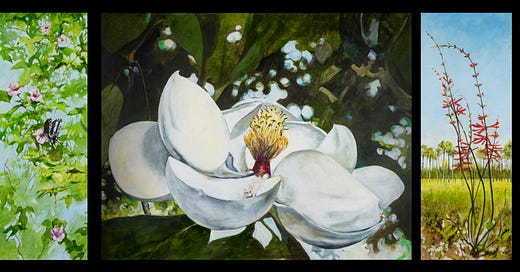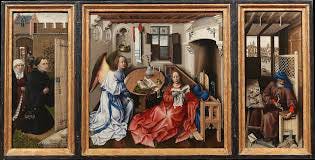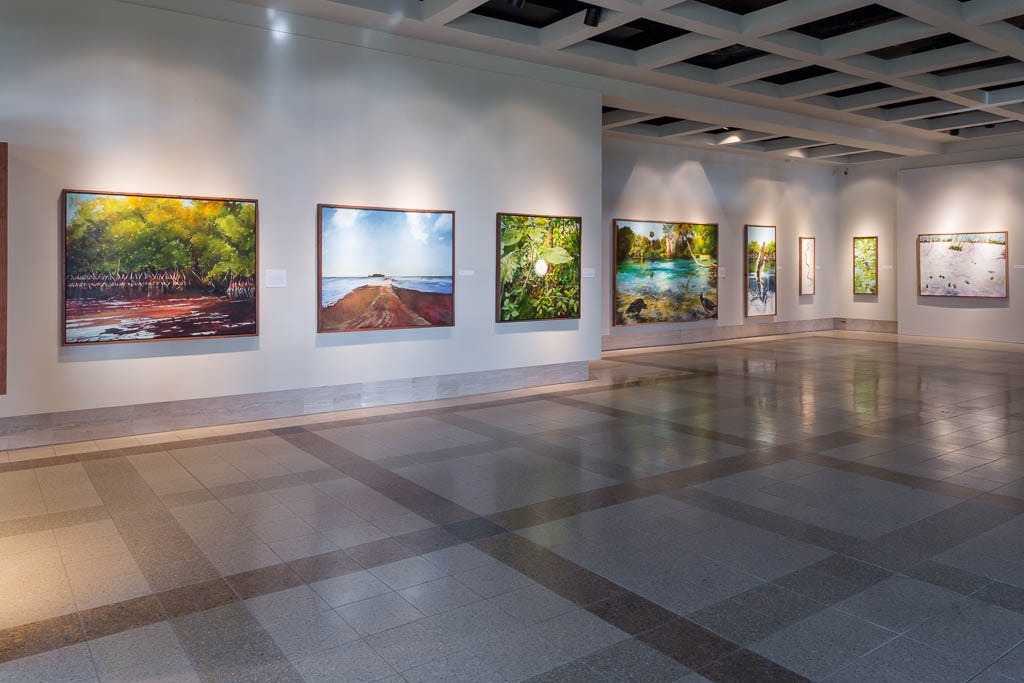Feast of Flowers: Morning glory with black swallowtail 48”x18”, Magnolia48”x60”, Cherokee bean48”x18’ all oil on canvas. 2012
As I started the Feast of Flowers project I spent the time trying to understand the historical context of New World expansion and colonization. For some reason I never put together the High Renaissance and the conquering of the west. Leonardo da Vinci was painting his iconic Last Supper as Christopher Columbus was making his various voyages to the West Indies. The Spanish Inquisition was also launched by Ferdinand and Isabella of Spain a few years before they funded the first trip of Columbus. Michelangelo’s Sistine Chapel Ceiling was finished the year before Ponce de Leon lifted his spyglass toward the Floridan peninsula.
When in creative pursuits it’s ineffective to pluck a single aspect of history out of context. Also, it is impossible to create in a vacuum. From my reading about the social and political climate in Europe at the beginning of the sixteenth century I gleaned a basic understanding of the colonization of the New World.
As an artist, I was interested in the practice of making paintings and the decorative embellishments that were part of the High Renaissance. The rise of a merchant class and the exceeding wealth of the Roman Catholic Church created a demand for the exotic. Artists scrambled to find more rich colors for their paintings. Dyes were needed to color the fine fabrics demanded by the rich. And of course, Gold. Everything had to be gilded.
Many of the voyages were launched to promote the color trade. Jewel-tones ruled the day. Blues and purples were a rare departure from the warm earth tones mined from the Italian landscape.
Merode Altarpiece, Robert Campin 1427-28 oil on oak panel The Cloisters Museum and Gardens, New York City.
While designing the visitor experience planned for Feast of Flowers I wanted to employ the feeling of a sanctuary. I appropriated devices from ecclesiastical venues and object of devotion. This journey was not new for me. Earlier in my career I used the devotional device of the icon to make a series of paintings called Healing Palms. These paintings were developed by observing the healing powers of the natural order as the Floridan landscape recovered from fires that raced across the peninsula. The Sabal Palmetto was the first to recover sprouting new green fronds as soon as the embers cooled. I replaced religious imagery in the icons with characters from the natural order.
Healing Palms each 48”x18” acrylic on canvas 2005
Thinking of ways to make the visitor experience for Feast of Flowers transcendent I started with basic ecclesiastical forms. There is a controlled symmetry evident in renaissance design. Formality rules. One early decision I made was to keep the dimensions of the paintings regular. I restricted the canvas heights to either 48” or 72”. My friend Donald Dusinberre made dark wooden frames. The materials for the surrounds was procured by another friend, Aaron Douglas. He set up a sawmill and milled indigenous woods from inadvertent collection. The trees were local live oak, cherry, pecan etc. These trees were felled as part of storms or taken down for building projects. I paired the species with the images portrayed on canvas.
I sat in the gallery anonymously as visitors marched through. I heard various sighs, and gasps and saw faces glistening with tears. My intention was not to make people cry but they did. I don’t think that there was anything especially transcendent about the individual paintings. They were fine. I did my best. By appropriating the effects used in ecclesiastical installations I was able to manufacture a transcendent experience.
Banner displayed at the entrance of The Cummer Museum of Art and Gardens beginning December 2012.
Installation view of Feast of Flowers.
Formal arrangement of paintings
Feast of Flowers
Paintings arranged to mimic ecclesiastical installations.
It is impossible to separate art, religion, politics, social engagement, fashion and decoration. All of these and more are part of an ever-evolving cultural landscape. Artists, designers, musicians and writers create new works in which they allude to the richly appointed past. Culture is a constantly evolving sphere. Each twist and turn takes the spectator into a new direction. The goal of the creator is to use each and every cultural reference available in order to make a statement or get across and idea. My idea in creating the Feast of Flowers exhibition was to celebrate the nature of the Floridan landscape instead of those who wished to conquer it. I’m not sure if everyone understood my intent, I’m OK with that. But I do know that few visitors left the exhibition thinking that it was not important.
Here is a little video in which religion, art and southern culture are blended in order to create something new.












It is always a joy and a revelation to see the other paintings you have done, Jim, and your comments just enrich the experience.